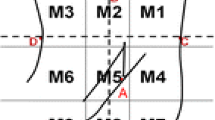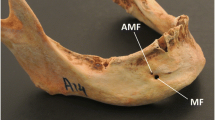Abstract
Fifty mandibles belonging to the Byzantium period were studied in order to determine to racial differences about of the localization of the mental foramen according to the mandibular teeth. Mandibles of adult males without missing teeth, proximal decay and proximal attrition were used. On the right side, the most common position of the mental foramen was between the first and second lower teeth (50%), whereas on the left side, the most common position was in line with the longitudinal axis of the lower second premolar tooth (46%). Because of materials including mostly Alpine's and a few of Mediterranean subraces, two different positions of the mental foramen were determined in high similar ratios.
Similar content being viewed by others
References
Freitas V., Madeira M.C., Toledo Filho J.L., Chagas C.F. (1979)Absence of the mental foramen in dry human mandibles. Acta Anat. 104:353–355.
Gershenson H., Nathan H., Luchansky E. (1986)Mental foramen and mental nerve: changes with age. Acta Anat. 126:21–28.
Green R.M. (1987)The position of the mental foramen: a comparison between the Southern (Hong Kong) Chinese and other ethnic and racial groups. Oral Surg. Oral Med. Oral Pathol. 63:287–290.
Hrdlicka A. (1930)The Skeletal Remains of Early Man. In: Smithsonian Miscellaneous Collections, Vol 83. City of Washington published by the Smithsonian Institution.
Ikiz, I., Cimen A. (1993)The measurements of the mental foramen, mandibular foramen and mandibular angels on the mandibles belonging to the Byzantium period. Journal of Uludaĝ University Medical Faculty. 1:9–11.
Kökten G., Arisan E., Baskaya F., Güngeç K.A. (1984)The topography of the mental foramen. Journal of Istanbul University Dentistry Faculty. 18(1–4):1–6.
Özbek M. (1984)The Byzantium Skeletions taken of the Antique Roman Theatre (Nice). Journal of Hacettepe University Literature Faculty. 2(1):81–89.
Santini A., Land M. (1990)A comparison of the position of the mental foramen in Chinese and British mandibles. Acta Anat. 137:208–212.
Snell R.S. (1992)Clinicall anatomy for medical students. Fourth edition, Little, Brown and Company, Printed in the United States.
Wang T.M., Shih C., Liu J.C., Kuo K.J. (1986)A clinical and anatomical study of the location of the mental foramen in adult Chinese mandibles. Acta Anat. 126:29–33.
Williams P.L., Warwick R., Dyson M., Bannister L.H. (1989)Gray's Anatomy. Thirty-Seventh Edition, Churchill Livingstone, Edinburgh, London, Melbourne and New York.
Author information
Authors and Affiliations
Rights and permissions
About this article
Cite this article
Ikiz, I., Erem, T. Relation of the mental foramen to teeth on the mandibles belonging to the Byzantium period. Int. J. Anthropol. 12, 1–4 (1997). https://doi.org/10.1007/BF02447884
Received:
Accepted:
Issue Date:
DOI: https://doi.org/10.1007/BF02447884




